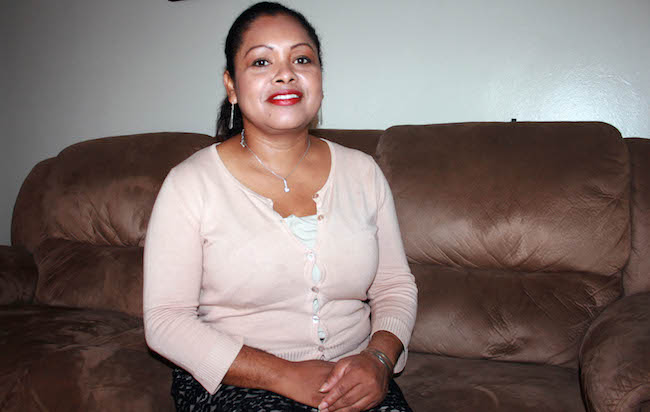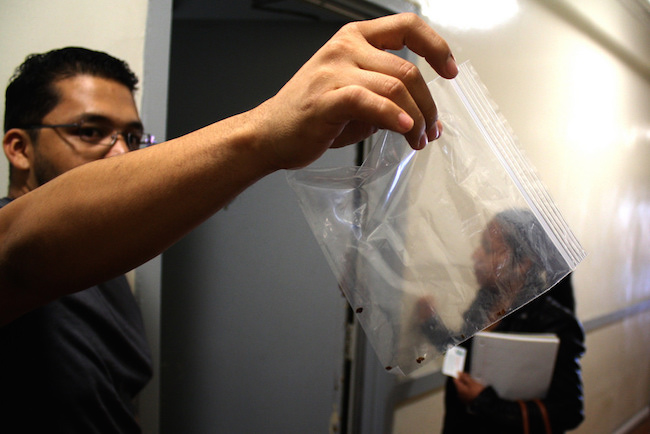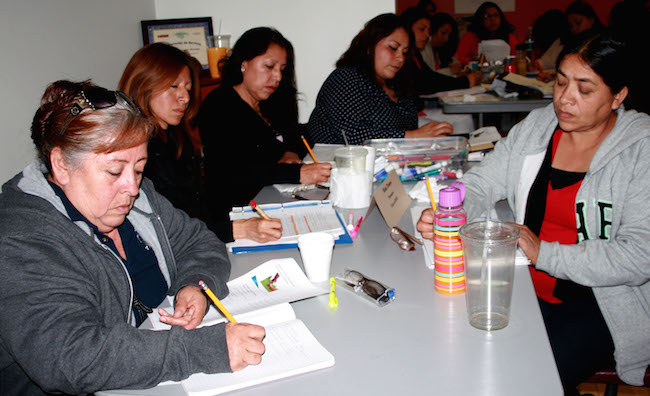By
Selene Rivera | Hoy LA
Soudi Jiménez | Hoy LA
This story is also available in Spanish.
This article was produced for Watts Revisited, a multimedia project launched by the USC Annenberg School for Communication and Journalism that explores challenges facing South L.A. as we commemorate the 50th anniversary of the 1965 Watts Riots. Learn more at www.wattsrevisited.com.

Juana Lopez had to move because her son Anthony was sick from asthma and the administrator of the building where she lived did not pay attention to her complaints.
The dust on the tables and carpet never worries Juana López, nor the condition of the paint on the walls of her home, even though her seven-year-old son Anthony Perez has suffered from asthma and allergies since 2013.
It was in a medical consultation where the doctor made it clear that there was a connection between the diseases and the environment around her child. “I did not know how to clean, or what products to use,” said Lopez, originally from Guerrero, Mexico.
The medical center referred López to the organization, Esperanza Community Housing. A health promoter said they urgently needed to change the carpet and repair areas where paint was falling off.
Such cases frequently arrive at Esperanza, a housing community helping low-income South L.A. families since 1989.
Experts point out that respiratory diseases such as asthma and allergies occur from lead poisoning, caused by the deplorable conditions in old buildings. “To detect lead, we collect paint samples and also dust, which are sent to the lab,” says Marjorie Aparicio, health promoter.
According to Gabriela Gonzalez, manager of the Healthy Homes Program at Esperanza, there is a housing crisis in neighborhoods in South L.A. In fact, 95 percent of those who use Esperanza’s services rent property.
“We document the conditions they live in, and tell the families their rights. In some cases, the owners threaten them to move or give them eviction letters,” she explains.
When the owners of the apartments oppose the tenant’s demands, the cases are brought to court, notes González, detailing that in these situations, people are always accompanied by professionals who know the landlords’ rights.
Because her apartment was never fixed, Lopez was forced to move out. It was then that she put into practice the advice she received from Esperanza Community Housing, realizing that now her little Anthony barely suffered from allergies.
“I had to throw away some pictures because they collected dust. Now I don’t use chemicals to clean. I use natural liquids with a vinegar base, water and bicarbonate. I try to have everything more clean because I want my son to be well,” she said.

Members of the organization Esperanza Community Housing show some of the pests that they found inside the apartments of a building located on the corner of 25th and Hobart streets in South Los Angeles.
A REALITY THAT HAS YET TO CHANGE
The history of the living conditions in South L.A. is devastating, said representatives from the organization Strategic Actions for a Just Economy (SAJE), which ensures that the neighborhoods meet the minimum requirements for healthy living. They indicated that each year about 48,000 people get sick from unsanitary conditions in the area in which they live.
Among the most common ailments are skin rashes, bites from cockroaches and rats, lead in the blood, fungal infections, chronic colds, respiratory symptoms, sore throats, sinusitis, asthma, ear infections and staph infections.
“Much of this happens because tenants do not know their rights, and they don’t know where to ask for help. Most of them don’t ask for much because they fear that the owner will increase the rent or threaten to evict them from properties where they pay $500 to $600,” says Nery Cividanis, SAJE community education specialist.
A survey conducted by the organization in 2010 with 140 tenants in South Los Angeles found that 75 percent of the people reported that they had cockroaches, 40 percent had rats or mice and 44 percent reported lack of running water for more than six hours a day. Also, 47 percent lived in homes where paint was peeling, 49 percent suffered chronic allergic symptoms, 25 percent reported suffering from asthma and another 15 percent reported lead poisoning.
“This is something we see every day. People come or call us asking for help. But what we are seeing is a new construction of apartments, and many landlords are using the technique of leaving their buildings neglected on purpose, so that people will leave the apartment so they can sell these properties,” says Cividanis.
“We’re talking about units up to 100 years old with plumbing problems, rodents and carpets installed more than 20 years ago. Children, elderly and sick people live there,” said the specialist.
The Los Angeles Health and Housing Department come to review the buildings every three years. However, “landlords have one week in advance to ‘patch’ problems,” says Cividanis.

South LA residents receive training from Esperanza Community Housing to be health promoters.
‘NONE OF THIS WILL CHANGE’
For Susie Meekins, who has lived in Watts for 66 years, these stories are not new.
“I have been livng here since 1948 and I can say that there have not been many changes in this area. The needs are not only limited to the property but to the neighborhood infrastructure also, with lack of parks, traffic lights, leveled sidewalks and alleys full of garbage,” said the African American activist. “After the 1965 riots, there has been five mayors here, five councilmen and four managers of community projects, but nothing has been done to improve the community in general,” said Meekins.
The activist says that the authorities in South L.A., especially Watts, engaged in work that fix the situation for a moment, but does not fix the underlying problem, but doing so, ensures that residents do not complain about housing conditions, infrastructure, or the neighborhood.
“People complain, everyone ignores them and finally they get tired and leave. Local government does not come out of their offices to see the conditions of neighborhoods and do something,” says Meekins. “None of this will change if the government does not ‘roll up hands’ and does the job it deserves.”
The total current cost to remedy the deteriorating housing conditions in Los Angeles would cost more than 400 million dollars, according to the organization. Currently there are from 5000 to 12000 housing units with poor living conditions in Los Angeles, which affects 40,000 people and the average amount of money needed to fix the problems of only one housing unit is 40,000 dollars.
Meanwhile, Los Angeles tenants lose about 10 million dollars in property damage because of the cockroaches and other types of pests as well as plumbing in disrepair, according to SAJE.
AN INEQUALITY FOR OVER HALF A CENTURY
Experts say that the history of violence and segregation in South Los Angeles has led to profound inequalities of health, environmental justice and housing in the area.
Until 1920, the area was a desirable place to live, but gradually the wealthy residents moved west. Under racially restrictive agreements, which allowed African Americans to obtain property only within areas of Slauson, Alameda, Washington and Watts, more middle class people of color arrived in the area during the Great Depression and World War II.
Because of the implementation of racial agreements in 1948, more African Americans populated the south of L.A., and the violence began to escalate.
The sales technique “demolishing or blackbusting” accelerated the growth of the minority population in the area. Many bought houses on a street with white owners, then sold or rented to a family of color. Thus, the seller had a chance to buy the rest of the houses in the street at a much lower rate to sell them to more minorities families.
Racial tension reached its highest point on August 11, 1965, when six days of rioting put Watts on the map and left 34 dead, over a thousand injured, about 4,000 arrested and about 40 million in damages in the area.
Since then, South L.A. still has a reputation in violence, high unemployment, lack of affordable housing and a large number of neglected buildings. Years later, little by little a new community from south of the border with a different language began to arrive. They rented some of the apartments and buildings and they still live there today.
The 2000 Census report revealed a population of 520,461 inhabitants of the area with 55 percent Latino and 45 percent African American. In 2010 the numbers increased to 65 percent Latino, 25 percent African American and 10 percent other groups.
INSPECTIONS EVERY FOUR YEARS
Under the law, city inspectors should review the apartments every four years and report the violations. Landlords or owners are notified 30 days in advance. If violations are found, the landlords must fix the problem within 30 days. If they do not do so, they must attend a hearing where they are given a deadline to fix the problem. If they ignore date, a tenant’s case may be referred to the city prosecutor and the property may be subject to the Rent Escrow Account Program (REAP). At this point, landlords will have to pay a fine of $50 monthly per unit until the problem is resolved.
Under REAP, people who rent have the option of paying their monthly payment to a city department separately instead of paying to the property owner. This is meant to motivate the landlord to solve the problem soon so they can receive their rent payments. Tenants are often eligible for a 10 to 50 percent reduction in rent based on the property damage.
Of the approximately 110,000 rental buildings in the city, there are currently 887 properties under the REAP program, which is less than 1 percent of housing under the program. Another total of 3,945 properties are subject to this program.
The Los Angeles Health and Housing Department estimates a total of 780,000 units of rental housing throughout the city of Los Angeles.
So far this year, the number of inspections regarding housing complaints is 2,770, of which 850 have been issued warnings to abide by the laws. Meanwhile, 3,500 others are also warned after reaching the inspection period.
People do not need to wait the four-year cycle inspection to report violations. Any affected person may call at any time, and does not have to reveal their identity.
What people should know
- If you live in a house that was built before 1978, there is risk of lead, especially if there are signs of peeling paint.
- Iron, calcium and vitamin C help lower blood lead levels.
- To avoid contamination, start by throwing away leftover food after eating, washing dishes immediately and taking out the trash every day.
- A tenant is entitled to ask the manager or owner of apartments to disinfect and repair homes to prevent the presence of contaminants.
- A tenant’s legal status does not matter when it comes to denouncing poor housing.
This story also appeared on Hoy LA.















Speak Your Mind